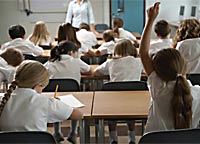Parents look to alternative schools to fill a void
 Louisiana educational standards are always a major topic of discussion, whether politically or among parents of school-age children. Our state is not ranked highly nationwide with respect to grades, standardized test scores or our educational system as a whole. In fact, we are near the bottom. Out of the 50 states, we usually jockey for a position in the forties. Currently, Louisiana is 44th in the nation in educational rankings. There is little wonder why parents seek out a better educational path for their children.
Louisiana educational standards are always a major topic of discussion, whether politically or among parents of school-age children. Our state is not ranked highly nationwide with respect to grades, standardized test scores or our educational system as a whole. In fact, we are near the bottom. Out of the 50 states, we usually jockey for a position in the forties. Currently, Louisiana is 44th in the nation in educational rankings. There is little wonder why parents seek out a better educational path for their children.
Having dwelled in the educational cellar for so long, it is not surprising that some New Orleans parents are looking to an alternative school system. With the slow return of the Orleans Parish schools, charter schools have emerged more prominently.
“More people want a choice in education,” says Tom Crosby, former head of school at the International School of Louisiana, a French/Spanish immersion school with a campus on Camp Street.
“However, the state is not pro-charter, and even now they are against it,” he continues. “And Governor Blanco is not pro-charter because of ties to the teachers’ union.”
Immersion schools involve a curriculum in which the students take their classes (except English) in their “target” language. There are some advantages to bilingual education: The students learn two sets of literature and traditions, as well as developing the ability to speak in another language.
While the International School is adding a grade each year as students progress, Lusher School has a K–12 curriculum. This charter school has been in existence since 1913 and became the first integrated public school in New Orleans, in 1960. The school has two campuses: Willow Street for kindergarten through fifth grade and the Fortier campus for grades six through 12.
Lusher has a curriculum that revolves around the visual arts, dance, music, theater and other disciplines, and it boasts that it is a model of “what’s right in the New Orleans public school system.” Administrators describe the educational experience as “a rigorous college preparatory curriculum … in which students are supported and encouraged to meet high expectations.”
Lusher’s admission system is two-part. Since the elementary school is in an attendance district, it is a neighborhood school for students within that district. Students from elsewhere in the city can apply for placement as availability exists.
Pam Stewart, director of marketing and development at the International School, says that the school has a random late-January kindergarten lottery system. Children go through an assessment process, the Gesell Developmental Test (Arnold Gesell started a child development clinic at Yale in 1911 and served as its director for 37 years). ISL will admit older students only if they are sufficiently experienced in the language in which they will study. Its system also takes a certain number of at-risk students.
“Unlike entering into a monolingual school, the assessment determines if a student is ready for bilingual education,” says Stewart. “It tells us how ready a student is for this education, but does not assess language ability.” ISL students divided by target language breaks down to about 55% Spanish and 45% French.
“Orleans Parish did not offer me the choices I felt I needed for my children,” says one mother who had two boys at ISL. “Plus I wanted them to learn to speak French with a statesponsored education.”
